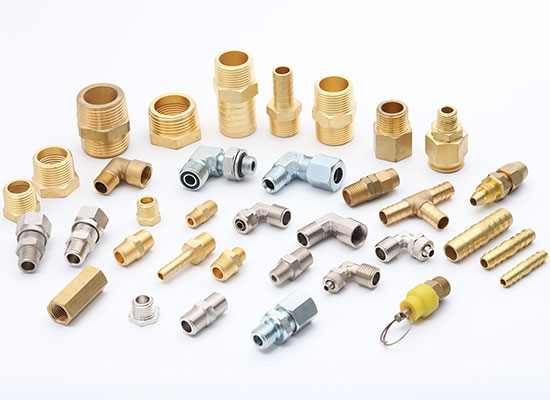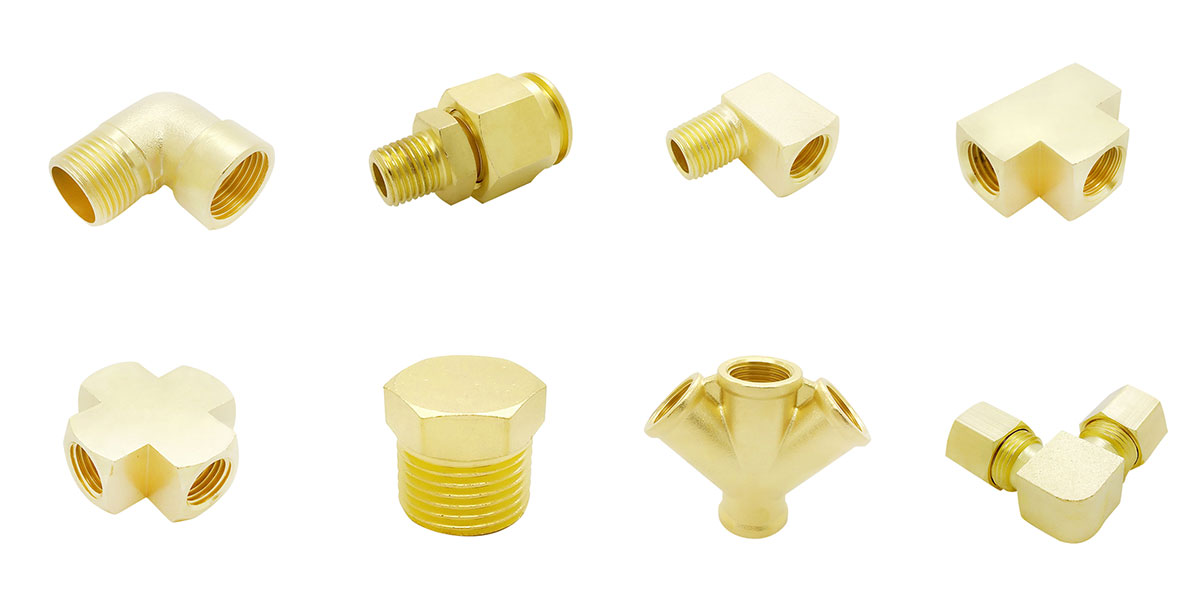
Brass Pipe Fitting is a versatile and durable component used to connect, redirect, or control the flow of fluids in piping systems. Made from high-quality brass, these fittings offer excellent corrosion resistance and are suitable for both low and high-pressure applications.
Brass Pipe Fitting is commonly used in plumbing, heating, and pneumatic systems due to its strength, reliability, and ease of installation. The material's resistance to corrosion ensures long-lasting performance, making it ideal for both indoor and outdoor use in various industries.
As a trusted Brass Pipe Fittings supplier based in China, Fokca (Fescolo) specializes in providing high-quality brass fittings for a wide range of applications.
Our brass pipe fittings are designed for superior durability, leak-free connections, and ease of installation, making them ideal for industrial, residential, and commercial systems.
At Fokca, we offer a diverse selection of brass pipe fittings, including elbows, tees, couplings, and reducing fittings, available in various sizes and configurations to meet your specific needs.
Brass pipe fittings are available in a wide range of sizes to suit different pipe diameters and application needs.
Common sizes include:
◆ 1/8 inch brass pipe fittings
Ideal for small, low-pressure applications.
◆ 1/4 inch brass pipe fittings
Popular for residential and light industrial systems.
◆ 3/8 inch brass pipe fittings
Used in medium-duty systems like heating or plumbing.
◆ 1/2 inch brass pipe fittings
Common for household plumbing and small industrial systems.
◆ 3/4 inch brass pipe fittings
Used in residential and commercial plumbing.
◆ 1 inch brass pipe fittings
Suitable for larger systems in commercial or industrial settings.
◆ 1 1/4 inch brass pipe fittings
Designed for higher capacity systems, like irrigation or industrial piping.
◆ 1 1/2 inch brass pipe fittings and larger
Typically used for heavy-duty applications in industries such as construction or large-scale systems.
Brass pipe tee fittings are used to create a branch in a piping system, allowing fluid or gas to flow in three directions.
These fittings are typically shaped like the letter "T" and are available in various sizes to match the pipe diameter. They are commonly used in plumbing and industrial applications.
Brass elbow pipe fittings are designed to change the direction of the pipe, available in 90-degree or 45-degree angles.
These fittings are essential for redirecting the flow of water, gas, or air in a piping system, and they come in various sizes for different pipe diameters.
◆ Union Brass Pipe Fittings
Union brass pipe fittings are used to join two pipes or fittings, with a mechanism that allows easy disconnection and reconnection without cutting the pipe.
This makes them ideal for systems where frequent maintenance or repairs are required, ensuring easy assembly and disassembly.
◆ Brass Pipe Adapters Fittings
Brass pipe adapters fittings are used to connect two pipes of different sizes or types. They are commonly used to transition between different materials, such as connecting a brass pipe to a PVC or steel pipe.
These fittings ensure a secure and leak-proof connection.
Brass pipe reducer fittings are designed to reduce the size of a pipe, allowing a larger pipe to connect to a smaller pipe.
These fittings help maintain flow efficiency and prevent system pressure loss. They are commonly used in various systems, including water distribution, gas systems, and industrial applications.

The pressure rating of brass pipe fittings indicates the maximum internal pressure the fitting can safely withstand without failure or leakage.
This is an important consideration when selecting fittings for any application, as using fittings with an inadequate pressure rating could lead to system failure or accidents.
◆ Material Composition: Brass alloys, such as C36000 and C37700, are commonly used for pipe fittings.
These materials provide strength, corrosion resistance, and durability, which are essential for withstanding high-pressure conditions.
◆ Size of the Fitting: The size of the fitting plays a significant role in determining its pressure rating.
Smaller fittings (e.g., 1/8 inch brass pipe fittings) generally have lower pressure ratings than larger fittings (e.g., 1-inch brass pipe fittings), as larger fittings tend to have thicker walls, offering better pressure resistance.
◆ Type of Fitting: The design of the fitting, whether it's a tee, elbow, union, adapter, or reducer, can also influence the pressure rating.
Generally, threaded fittings offer higher pressure tolerance than compression or push-to-connect fittings, as they provide more secure seals.
◆ 1/8 inch brass pipe fittings: Up to 2000 psi
◆ 1/4 inch brass pipe fittings: Up to 2000-3000 psi
◆ 1/2 inch brass pipe fittings: Up to 1500-2000 psi
◆ 3/4 inch brass pipe fittings: Up to 1500 psi
◆ 1 inch brass pipe fittings: Up to 1000-1500 psi
◆ 1 1/4 inch and larger brass pipe fittings: Typically up to 1000 psi or higher for heavy-duty applications.
| Feature | Brass Pipe Fittings | Stainless Steel Pipe Fittings |
| Corrosion Resistance | Good, but less resistant in harsh environments | Excellent, especially in harsh and marine environments |
| Durability | Durable, but more prone to wear and tear | Extremely durable, ideal for high-pressure and high-stress systems |
| Strength | Moderate strength, suitable for lower pressure systems | High strength, ideal for high-pressure, high-temperature environments |
| Cost | More affordable, suitable for residential and light industrial applications | More expensive, suitable for specialized industrial applications |
| Appearance | Gold-like, decorative look | Silvery, metallic look, blends into industrial environments |
| Applications | Water, gas, heating, residential systems | Food processing, pharmaceuticals, oil & gas, marine |
◆ Water and Plumbing Systems
◆ Gas Systems (Natural gas, propane)
◆ HVAC Systems (Heating, Ventilation, Air Conditioning)
◆ Automotive and Engine Components
◆ Marine and Shipbuilding
◆ Chemical and Pharmaceutical Industries
◆ Oil and Gas Industry
◆ Food and Beverage Processing
◆ Fire Protection Systems
◆ Pneumatic Systems
◆ Hydraulic Systems
1. Brass Pipe Fittings HS Code
The HS Code for brass pipe fittings typically falls under 730793 or 741220, depending on the specific product and material.
It’s important to check with customs or a supplier for the exact code based on your location and the type of fitting.
2. Brass Pipe Fittings Catalog
A brass pipe fittings catalog provides a comprehensive listing of different types of brass fittings, such as tees, elbows, unions, adapters, reducers, and their specifications (sizes, pressure ratings, materials, etc.).
You can usually obtain a catalog directly from manufacturers or suppliers like Fokca (Fescolo).
3. What is High Pressure Brass Pipe Fittings?
High-pressure brass pipe fittings are designed to withstand high internal pressures, typically used in applications involving compressed air, gas lines, or hydraulic systems.
These fittings are made from high-strength brass alloys and are often used in environments where pressure exceeds typical residential levels.
4. How to Connect Brass Pipe Fittings?
To connect brass pipe fittings, follow these general steps:
Clean the pipe ends to ensure a smooth surface.
Apply thread sealant (if using threaded fittings) or tighten compression fittings using the appropriate tool.
Screw or press-fit the fittings into place and tighten them securely.
Check for leaks after installation.
The connection method may vary depending on whether the fittings are threaded, compression, or push-fit.
5. How to measure brass pipe fittings?
To measure brass pipe fittings, determine the outer diameter (OD) of the pipe, and if the fitting is threaded, measure the thread diameter and count the threads per inch (TPI).
For fittings like elbows or unions, measure the length or width to ensure a proper fit.
For more detail you can contact us.
Links: www.fescolo.com(Pneumatic)
FOKCA ©1998-2025 All Rights Reserved Sitemap